MOONS - Multi Object Optical and Near-infrared Spectrograph for the VLT
Content
MOONS will be a multi-objects spectrograph mounted at a Nasmyth focus at the VLT. It will have ~1000 fibers deployable over a field of view of ~500 square arcmin. The total wavelength coverage is from 0.6 micron to 1.8 micron, accessed in medium and high resolution modes. In the medium resolution mode (R~4,000-6,000) the entire wavelength range 0.65-1.8 micron is observed simultaneously, while the high resolution mode covers simultaneously two selected spectral regions: one around the CaII triplet (at R~9,000) to measure radial velocities, a second at R~20,000 in the H-band, for detailed measurements of chemical abundances.
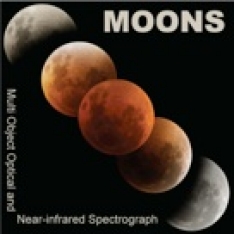
| Principal Investigators | Michele Cirasuolo (ESO), Jose Afonso (Portugal), Marcella Carollo (Switzerland), Chris Evans (UK), Hector Flores (France), Roberto Maiolino (UK), Ernesto Oliva (Italy), Stephane Paltani (Switzerland), Leonardo Vanzi (Chile) |
| Project Manager | Alasdair Fairley (UK ATC) |
| Project Engineer |
Phil Rees (UK ATC) |
| Consortium |
|
| ESO Project manager | Peter Hammersley (phammer@eso.org) |
| ESO Project scientist |
Amelia Bayo (abayo@eso.org) |
| ESO Project Engineer | Antonio Manescau (amanesca@eso.org) |
| Project Status | MAIT |
| Location | Nasmyth focus at UT1, VLT |
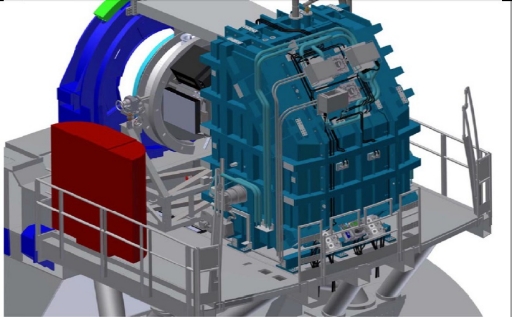
Milestones
- Preliminary Design Review (PDR) – March 2016
- Final Design Review (FDR) – March 2017
- PAE scheduled for Q2 2024
Instrument Description
MOONS will be a fibre-fed multi-object spectrograph covering from 0.65 micron till 1.8 micron operating from UT1. The instrument consists of a rotating part, which will be mounted on the VLT Nasmyth rotator, and the spectrographs that will be mounted on the Nasmyth platform. The fibre assemblies provide the connection between the rotating part of the instrument and the two static spectrographs.
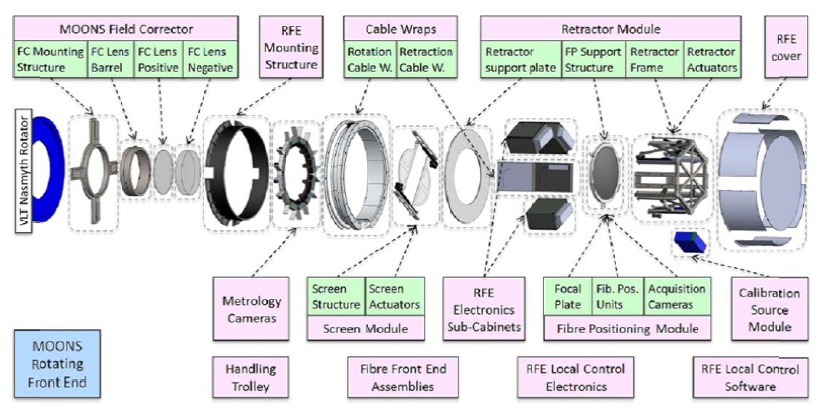
The rotating part of the instrument and the cable wrap will collectively be known as the rotating front-end (RFE) of the instrument. It consists of:
- Field corrector
- RFE structure and cable wrap
- Calibration module
- Acquisition camera module
- Fibre pick-off module
- Metrology camera module
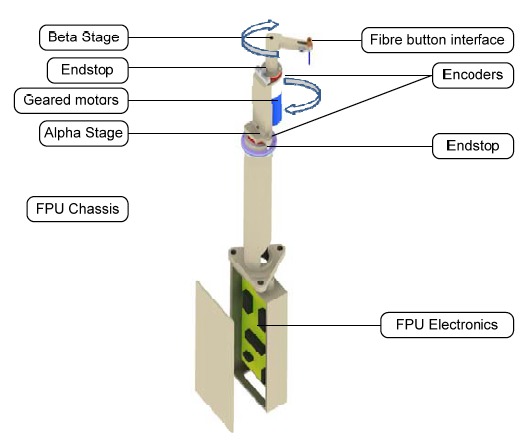
After the setup of the observations by the astronomer, the instrument will move the fibre positioners into the correct position within their own patrol field. The concept of the fibre positioners is two rotating mechanisms, one on the top of the other. The length of the arms has been chosen to maximise the field coverage such taht there are no gaps on the field. The location of the arms can then be verified using a set of cameras placed around the outside of the RFE. The plate must be retracted from the observing position in order to allow space for the camers to work.
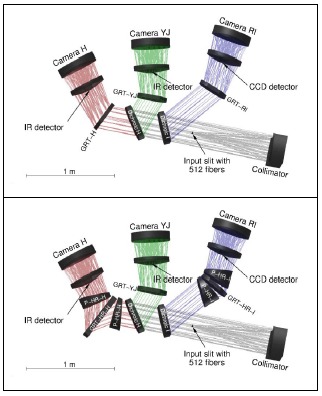
Two spectrographs are required due to the large number of fibres. A single cryostat will contein both of them, in order to reduce the overall mass and volume of the instrument. Each spectrographs will simultaneously obtain spectra in the three wavebands, namely RI, YJ and H. A pair of dichroic filters is used to split the light into the three bands. In each band the light will be dispersed and then imaged through a camera onto its associated detector. A CCD detector will be used for the shortest waveband (RI), while Teledyne Hawaii 4RG detectors will be used for the two longer wavebands (YJ and H). The baseline design consists of two optically identical spectrogrphs. Each slit connects to 512 fibres, with a slit length of 200 mm.
Baseline Specification
| Requirement | Baseline Specification |
| Field-of-View | 500 arcmin2 |
| Fibre multiplex per pointing | 1000 |
| Smallest target separation | <10″ |
| Sky projectsd diameter of each fiber |
1.0 arcsec |
| Wavelength coverage |
0.65 - 1.8 micron |
| Observing modes |
medium resolution (MR) and high resolution (HR) |
| Observing Mode / Band | Spectral coverage | R (at central lambda) | Comment |
| MR-RI | 0.647 - 0.955 | 4,100 | Simultaneous in MR mode |
| MR-YJ | 0.934 - 1.350 | 4,300 | |
| MR-H | 1.452 - 1.800 | 6,600 | |
| HR-I | 0.765 - 0.898 | 9,200 | Simultaneous in HR mode |
| MR-YJ | 0.934 - 1.350 | 4,300 | |
| HR-H |
1.521 - 1.641 | 18,300 | |
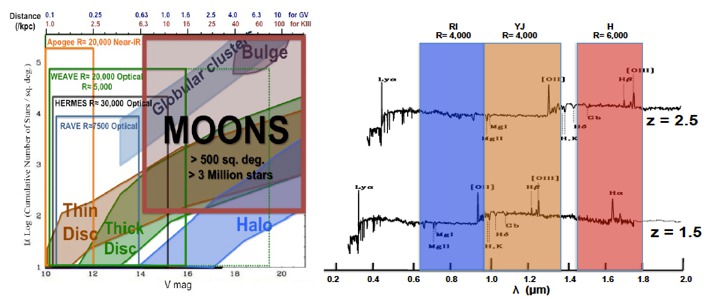
Scientific Objectives
MOONS will be a versatile instrument that will provide ESO and the astronomical community with the observational power necessary to tackle a wide range of Galactic, extragalactic and cosmological studies. Some of the main science cases that are driving the MOONS design are the following:
- Galactic archeology. The study of the resolved stellar populations of the Milky Way and other Local Group galaxies can provide us with a fossil record of their chemo-dynamical and star-fomation histories. MOONS will provide a crucial follow-up for the Gaia mission and for Galactic surveys with the VISTA telescope, delivering accurate radial velocities, metallicitites and chemical abundances for several million stars. The near-IR coverage of MOONS will allow to investigate the nature of the heavily-obscured regions of the Galactic bulge.
- The growth of galaxies. Tracing the assembly history of galaxies over cosmic time remains a primary goal for observational and theoretical studies of the Universe. Exploiting the large multiplex and wavelength coverage of MOONS will allow for the first time to obtain high quality spectra for a statistically significant number of galaxies (~1 million) at z>1.
- The first galaxies. The light from the first galaxies, just a few handred million years after the Big Bang is of great importance to understand the cosmic reionization. The unique combination of the 8m VLT aperture, wide-area coverage, and near-IR spectroscopy offered by MOONS will provide accurate distances, relative veleocities and emission-line diagnositcs for statistical samples of z>7 galaxies.
Finally, MOONS will provide the essential deep spectroscopic follow-up of current and future optical and near-IR imaging surveys (e.g. VISTA, VST, Pan-STARRS, LSST) and space mission (e.g. WISE, Athena).
References and external links
- MOONS Consortium web page
- "MOONS: The Multi-Object Optical and Near-infrared Spectrograph", The Messenger 145
- "MOONS: the Multi-Object Optical and Near-infrared Spectrograph for the VLT", Proceedings SPIE 2014
